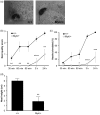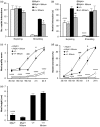Deficits in social behavioral tests in a mouse model of alternating hemiplegia of childhood
- PMID: 27276195
- PMCID: PMC4917910
- DOI: 10.1080/01677063.2016.1182525
Deficits in social behavioral tests in a mouse model of alternating hemiplegia of childhood
Abstract
Social behavioral deficits have been observed in patients diagnosed with alternating hemiplegia of childhood (AHC), rapid-onset dystonia-parkinsonism and CAPOS syndrome, in which specific missense mutations in ATP1A3, encoding the Na(+), K(+)-ATPase α3 subunit, have been identified. To test the hypothesis that social behavioral deficits represent part of the phenotype of Na(+), K(+)-ATPase α3 mutations, we assessed the social behavior of the Myshkin mouse model of AHC, which has an I810N mutation identical to that found in an AHC patient with co-morbid autism. Myshkin mice displayed deficits in three tests of social behavior: nest building, pup retrieval and the three-chamber social approach test. Chronic treatment with the mood stabilizer lithium enhanced nest building in wild-type but not Myshkin mice. In light of previous studies revealing a broad profile of neurobehavioral deficits in the Myshkin model - consistent with the complex clinical profile of AHC - our results suggest that Na(+), K(+)-ATPase α3 dysfunction has a deleterious, but nonspecific, effect on social behavior. By better defining the behavioral profile of Myshkin mice, we identify additional ATP1A3-related symptoms for which the Myshkin model could be used as a tool to advance understanding of the underlying neural mechanisms and develop novel therapeutic strategies.
Keywords: ATP1A3; mouse model; Alternating hemiplegia of childhood; social behavior.
Figures




References
-
- Bailey K.R., Crawley J.N.2009Anxiety-related behaviors in miceIn:Buccafusco J.J.Methods of Behavior Analysis in Neuroscience 2nd edBoca Raton: CRC Press
-
- Benarroch E.E. Na+,K+-ATPase: functions in the nervous system and involvement in neurologic disease. Neurology. 2011;76:287–293. - PubMed
-
- Boelman C., Lagman-Bartolome A.M., MacGregor D.L., McCabe J., Logan W.J., Minassian B.A. Identical ATP1A3 mutation causes alternating hemiplegia of childhood and rapid-onset dystonia parkinsonism phenotypes. Pediatric Neurology. 2014;51:850–853. - PubMed
-
- Dard R., Mignot C., Durr A., Lesca G., Sanlaville D., Roze E., Mochel F. Relapsing encephalopathy with cerebellar ataxia related to an ATP1A3 mutation. Developmental Medicine and Child Neurology. 2015;57:1183–1186. - PubMed
Publication types
MeSH terms
Supplementary concepts
Grants and funding
LinkOut - more resources
Full Text Sources
Other Literature Sources
Molecular Biology Databases
